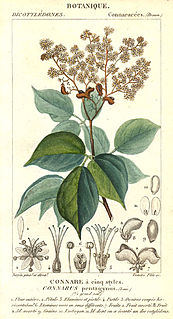
Bombacaceae were long recognised as a family of flowering plants or Angiospermae. The family name was based on the type genus Bombax. As is true for many botanical names, circumscription and status of the taxon has varied with taxonomic point of view, and currently the preference is to transfer most of the erstwhile family Bombacaceae to the subfamily Bombacoideae within the family Malvaceae in the order Malvales. The rest of the family were transferred to other taxa, notably the new family Durionaceae. Irrespective of current taxonomic status, many of the species originally included in the Bombacaceae are of considerable ecological, historical, horticultural, and economic importance, such as balsa, kapok, baobab and durian.

Hevea is a genus of flowering plants in the spurge family, Euphorbiaceae, with about ten members. It is also one of many names used commercially for the wood of the most economically important rubber tree, H. brasiliensis. The genus is native to tropical South America but is widely cultivated in other tropical countries and naturalized in several of them. It was first described in 1775.
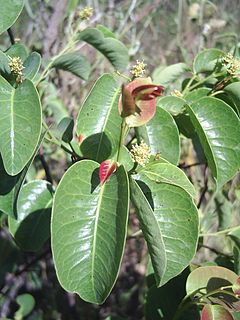
Maprounea is a plant genus of the family Euphorbiaceae first named as a genus in 1775. It is native to tropical Africa, Trinidad, and tropical Central and South America.
- Maprounea africana - W + C + S Africa, from Benin to Zimbabwe
- Maprounea amazonica - Colombia, Venezuela, N Brazil
- Maprounea brasiliensis - Brazil, Paraguay, Bolivia
- Maprounea guianensis - Trinidad, Panama, Colombia, Venezuela, French Guiana, Suriname, Guyana, Brazil, Peru, Ecuador, Bolivia, Paraguay
- Maprounea membranacea - Nigeria, Cameroon, Gabon, Equatorial Guinea, Cabinda, Central African Republic, Congo, Zaire

Vismia is a genus of flowering plants in the family Hypericaceae. Members of the genus are small trees and shrubs found in tropical and subtropical areas of Africa, Central America, and South America.
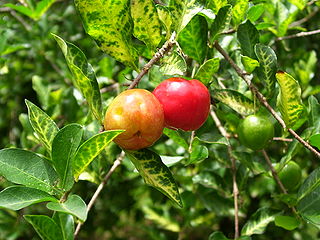
Malpighia is a genus of flowering plants in the nance family, Malpighiaceae. It contains about 45 species of shrubs or small trees, all of which are native to the American tropics. The generic name honours Marcello Malpighi, a 17th-century Italian physician and botanist. The species grow to 1–6 m (3.3–19.7 ft) tall, with a dense, often thorny crown. The leaves are evergreen, simple, 0.5–15 cm (0.20–5.91 in) long, with an entire or serrated margin. The flowers are solitary or in umbels of two to several together, each flower 1–2 cm (0.39–0.79 in) diameter, with five white, pink, red, or purple petals. The fruit is a red, orange, or purple drupe, containing two or three hard seeds. M. emarginata is cultivated for its sweet and juicy fruits, which are very rich in vitamin C.

Caryocar is a genus of flowering plants, in the South American family Caryocaraceae described as a genus by Linnaeus in 1771. It is native primarily to South America with a few species extending into Central America and the West Indies.

Jean Baptiste Christophore Fusée Aublet was a French pharmacist, botanist and one of the earliest botanical explorers in South America. He was one of the first botanists to study ethnobotany in the Neotropics.
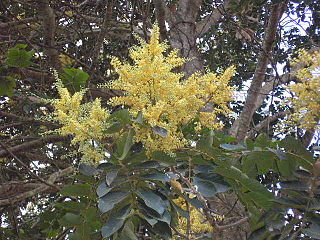
Tachigali is a flowering plant genus in the legume family (Fabaceae) that contains 54 species.

Parinari is a genus of plant in the family Chrysobalanaceae.
Perebea is a genus of plant in family Moraceae.

Picramnia, the bitterbushes, is a genus of plant considered to be in the family Picramniaceae, but sometimes placed in Simaroubaceae. The name is conserved against the genera Pseudo-brasiliumAdans., and TaririAubl., both which have been rejected.
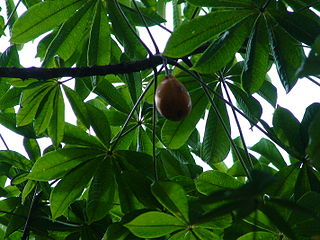
Jacaratia is a genus of shrubs or trees in the Caricaceae family. They are native to South and Central America.

Tolumnia Rafinesque, is a genus in the family Orchidaceae. Previously known as the "equitant Oncidiums," the species were segregated from the mega-genus Oncidium by Guido Braem in 1986. The plants are small, usually epiphytic, with small or absent pseudobulbs completely covered by leaves, which are triangular or circular in cross section and overlap each other at base to resemble a fan. The inflorescences arise between the leaf base and bear colorful, showy flowers. The labella are large, ornamented by variously shaped calli. The column bears prominent wings flanking the stigma. Dancing-lady orchid is a common name for some species in this genus.

Eperua is a genus of flowering plants in the legume family, Fabaceae. It belongs to the subfamily Detarioideae. The fifteen species belonging to this genus are distributed in the tropical zones of Africa and South America, living in the jungles, often along rivers or streams. The leaves are compound pinnate, with smooth margins, and the fruits are long pods. The wood of E. falcata is called wallaba and is often used in construction.

Mimusops balata is a species of flowering plant in the family Sapotaceae. It is native to Mauritius and Réunion.

Hernandia is a genus of flowering plants in the family Hernandiaceae. It was named after the Spanish botanist Francisco Hernández de Toledo.

Pachira is a genus of tropical trees distributed in Central and South America, Africa and India. They are classified in the subfamily Bombacoideae of the family Malvaceae. Previously the genus was assigned to Bombacaceae. Prior to that the genus was found in the Sterculiaceae.
Schnella is a genus of flowering plants in the legume family, Fabaceae. It belongs to the sub family Cercidoideae.
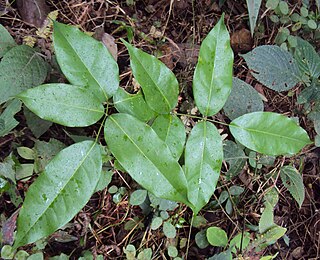
Rourea minor is a large scandent shrub from the family Connaraceae. It has been recorded from Africa, tropical Asia and the Pacific.
Fusaea is a genus of plants in the family Annonaceae. It comprises three species distributed in Brazil, Colombia, Ecuador, French Guiana, Guyana, Peru, Suriname and Venezuela.

